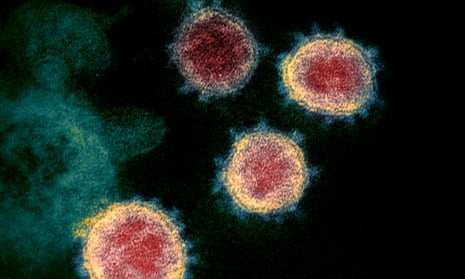New research has shed light on a crucial biological mechanism that may have helped the coronavirus to infect humans and spread rapidly around the world.
A detailed analysis of the virus’s structure shows that the club-like “spikes” that it uses to establish infections latch on to human cells about four times more strongly than those on the related Sars coronavirus, which killed hundreds of people in a 2002 epidemic.
The finding suggests that coronavirus particles that are inhaled through the nose or mouth have a high chance of attaching to cells in the upper respiratory tract, meaning that relatively few are needed for an infection to gain a foothold.
Scientists at the University of Minnesota used X-ray crystallography to create an atomic-scale 3D map of the virus’s spike protein and its corresponding partner on human cells, known as the ACE-2 receptor.
When the virus encounters a human cell, the spike proteins on its surface stick to ACE-2 receptors, if the cell possess them, and allow the virus to gain access and replicate.
Quick GuideWhat to do if you have coronavirus symptoms in the UK
Show
Symptoms are defined by the NHS as either:
- a high temperature - you feel hot to touch on your chest or back
- a new continuous cough - this means you've started coughing repeatedly
NHS advice is that anyone with symptoms should stay at home for at least 7 days.
If you live with other people, they should stay at home for at least 14 days, to avoid spreading the infection outside the home.
After 14 days, anyone you live with who does not have symptoms can return to their normal routine. But, if anyone in your home gets symptoms, they should stay at home for 7 days from the day their symptoms start. Even if it means they're at home for longer than 14 days.
If you live with someone who is 70 or over, has a long-term condition, is pregnant or has a weakened immune system, try to find somewhere else for them to stay for 14 days.
If you have to stay at home together, try to keep away from each other as much as possible.
After 7 days, if you no longer have a high temperature you can return to your normal routine.
If you still have a high temperature, stay at home until your temperature returns to normal.
If you still have a cough after 7 days, but your temperature is normal, you do not need to continue staying at home. A cough can last for several weeks after the infection has gone.
Staying at home means you should:
- not go to work, school or public areas
- not use public transport or taxis
- not have visitors, such as friends and family, in your home
- not go out to buy food or collect medicine – order them by phone or online, or ask someone else to drop them off at your home
You can use your garden, if you have one. You can also leave the house to exercise – but stay at least 2 metres away from other people.
If you have symptoms of coronavirus, use the NHS 111 coronavirus service to find out what to do.
Source: NHS England on 23 March 2020
“The 3D structure shows that compared to the virus that caused the 2002-2003 Sars outbreak, the new coronavirus has evolved new strategies to bind to its human receptor, resulting in tighter binding,” said Dr Fang Li, who led the US team. “The tight binding to the human receptor can help the virus infect human cells and spread among humans.”
The map of the virus will now be used by scientists to search for potential drugs that can neutralise the virus before replication has ramped up and the infection has taken hold. “If a new antibody drug can bind to those sites on the virus more strongly and frequently than the receptor, it will block the virus out of cells, making it a potentially effective treatment for viral infections,” Li said. The same sites can be used to shape work on vaccines to prevent future infections, he added.
Writing in the journal Nature, the researchers describe how they went on to compare the structure of the pandemic coronavirus with related strains found in bats and pangolins. They found that both animal strains could bind to the same human ACE-2 receptor, supporting previous work that suggests the human coronavirus came from bats either directly, or via pangolins that themselves became infected by bats. Before infecting humans, the animal strains picked up key mutations that allowed the virus to spread more easily in humans.
“We know that the Covid-19-causing coronavirus, Sars-CoV-2, behaves very differently to its relative Sars,” said Jonathan Ball, a professor of virology at Nottingham University, who was not involved in the study. “In particular, Sars-Cov-2 efficiently infects the throat and the nose, causing mild cold-like symptoms, whereas Sars almost always replicated in the lungs.
“This study provides an attractive reason for this difference: the Sars-CoV-2 surface spike protein is able to bind more efficiently to the cell-surface protein, called ACE-2, which acts as the doorway for these viruses to enter into the cell. This improved binding might allow the virus to infect the nose and the throat more efficiently, where the levels of ACE-2 are thought to be lower.”
“The study only used fragments of the virus spike and host ACE-2 protein, and this is still only a theory,” he added. “The exact implications will need validation through further experimentation.”
